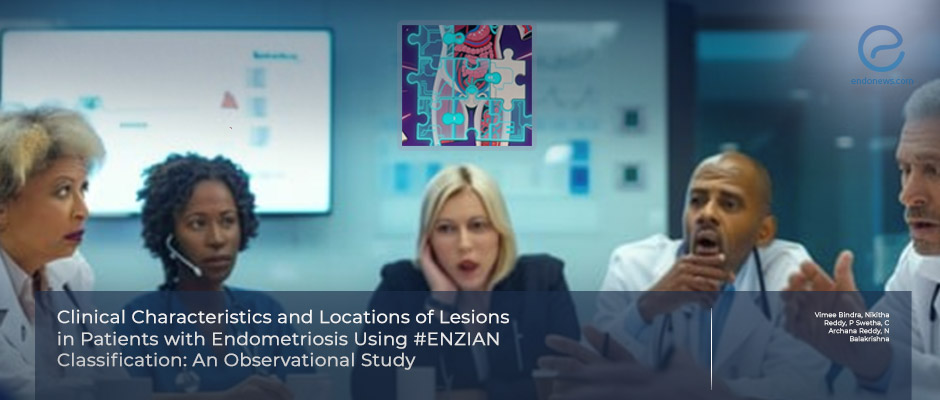The ENZIAN System Provides a Unique Language Among Clinicians
Nov 19, 2025
A large single-surgeon cohort demonstrates how the #ENZIAN system captures detailed lesion distribution in endometriosis.
Key Points
Highlights:
- The #ENZIAN classification effectively captures the distribution and severity of deep, ovarian, and peritoneal endometriosis in a real-world surgical cohort.
Importance:
- Precise lesion description improves communication among clinicians and supports surgical planning, especially in complex deep endometriosis.
- #ENZIAN provides a standardized language that complements rASRM by detailing compartment-specific disease burden.
What’s done here:
- A retrospective observational study was conducted on 154 women with surgically confirmed endometriosis.
- All cases were performed by a single minimally invasive gynecologic surgeon at a multidisciplinary endometriosis center.
- Lesions were systematically classified according to #ENZIAN compartments (A, B, C, F, O, P, T, and adhesion codes).
- Clinical characteristics—including symptoms, disease stage, and anatomical site of lesions—were documented and correlated with #ENZIAN patterns.
Key results:
- Deep infiltrating endometriosis (compartments A, B, C) was present in a substantial proportion of patients, with compartment B (parametrial) most frequently involved.
- Left-sided lesions were significantly more common than right-sided lesions, while 46.1% had bilateral involvement.
- Ovarian endometriomas (O) and peritoneal disease (P) frequently co-existed with deep lesions, reflecting multifocal and multi-compartment disease.
- A sizable subset demonstrated concomitant uterosacral, rectovaginal, and rectosigmoid involvement, highlighting the complexity of surgical management.
- rASRM staging alone did not fully describe the anatomical severity captured by #ENZIAN.
Strength and Limitations:
- Single-surgeon cohort reduces inter-observer variability and allows consistent #ENZIAN mapping across all cases, is the strengths of the paper.
- Limitations are: Retrospective single-center design (limits generalizability); lack of postoperative outcomes (prevents correlation between #ENZIAN stages and clinical improvement).
From the Editor-in-Chief – EndoNews
"The adoption of standardized endometriosis classification remains one of the most persistent gaps in both clinical practice and research. This study from India demonstrates how the #ENZIAN system can bring much-needed anatomical precision to the description of deep infiltrating disease—something traditional scoring frameworks like rASRM inherently lack. By applying a compartment-based approach across more than 150 surgically confirmed cases, the authors highlight the multi-focal and asymmetric nature of deep lesions, illustrating why a one-dimensional severity score cannot capture the full surgical reality.
What stands out is not only the detailed mapping of retroperitoneal disease but also the system’s capacity to guide interdisciplinary communication. A radiologist reading MRI, a surgeon planning excision, and a clinician counseling a patient all benefit from speaking the same structured language. ENZIAN’s ability to track whether recurrent lesions appear in the same compartment—or emerge de novo elsewhere—is an additional advantage that supports longitudinal follow-up and outcome comparison across centers.
However, the broader implication of this work goes beyond national boundaries. Endometriosis care is inherently multidisciplinary and international, and classification systems must be validated across radiology, minimally invasive surgery, pathology, and reproductive medicine. While this cohort contributes important regional data, advancing global standards will require formal radiologic–surgical correlation studies, reproducibility testing across institutions, and integration with evolving imaging-based or molecular frameworks.
Still, this study reinforces a clear message: when clinicians share a precise descriptive system, patient care becomes safer, more consistent, and more comparable worldwide. ENZIAN has the potential to serve as that common language—and studies like this lay the groundwork for its broader adoption."
Lay Summary
A new study from India highlights how the #ENZIAN classification system provides a clearer and more detailed way to describe endometriosis lesions compared with traditional systems. The findings, published in The Journal of Obstetrics and Gynecology of India, emphasize ENZIAN’s value as a shared language among radiologists, surgeons, and clinicians—especially when dealing with the complex anatomy of deep infiltrating endometriosis.
The research team, led by Dr. N. Balakrishna from the Apollo Institute of Medical Sciences and Research in Hyderabad, retrospectively evaluated 154 women (average age 32) who underwent laparoscopic or robotic excision of endometriosis between April 2021 and September 2022. Nearly half had previously received medical therapy, and infertility was present in about 41% of participants.
By assigning lesions to ENZIAN compartments, the study captured a highly detailed map of disease distribution: Ovarian involvement was common, with left-sided lesions in 67.4% and bilateral lesions in 46.1% of patients. Rectovaginal septum, vagina, and posterior compartment disease (ENZIAN A) were present in 61% of cases. Uterosacral ligaments and pelvic sidewall involvement (ENZIAN B) affected both sides frequently, slightly more on the left. Deep lesions involving the rectum and sigmoid colon (ENZIAN C) were observed in 33.1% of patients.
These findings show how the ENZIAN system reveals multi-compartment and often asymmetric disease patterns that may be overlooked by rASRM, which does not assign specific depth- or location-based information for deep lesions. Because ENZIAN can distinguish whether recurrent disease appears in the same site or a new anatomical compartment, it also supports long-term follow-up and comparative assessments across surgeries.
According to the study authors, using #ENZIAN improves reproducibility, enhances surgical planning, and strengthens communication across specialties—making it a valuable tool for centers managing complex endometriosis.
Research Source: https://pubmed.ncbi.nlm.nih.gov/40390882/
ENZIAN endometriosis stage classification deep infiltrating endometriosis

